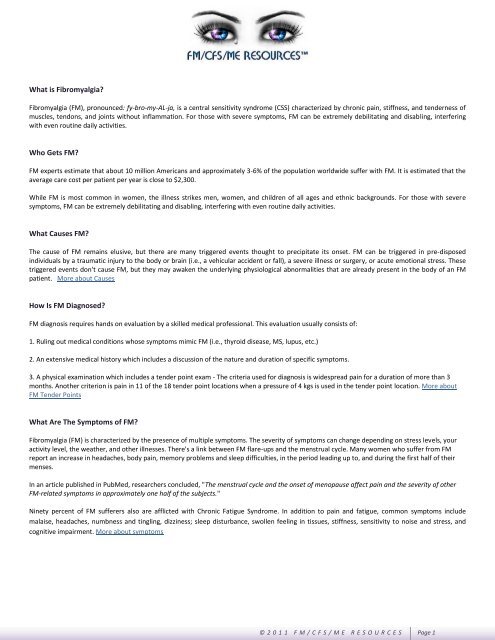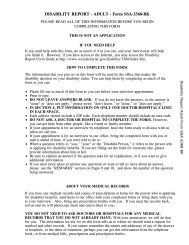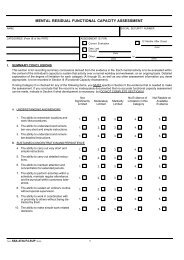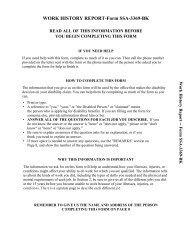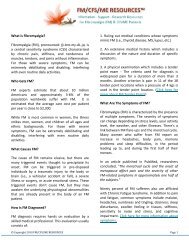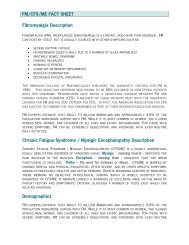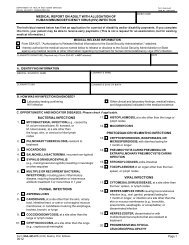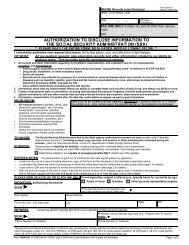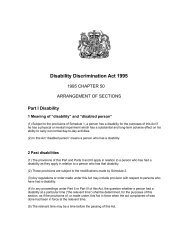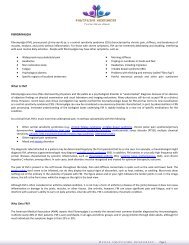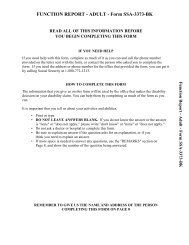What is Fibromyalgia? - FM/CFS/ME Resources
What is Fibromyalgia? - FM/CFS/ME Resources
What is Fibromyalgia? - FM/CFS/ME Resources
Create successful ePaper yourself
Turn your PDF publications into a flip-book with our unique Google optimized e-Paper software.
Types of <strong>FM</strong> Pain (Continued)Knife in the Voodoo DollSometimes, out of nowhere, I'll get an intense stabbing pain that seems to cut through my body. I've also described th<strong>is</strong> as a fireplace pokerin the ribs or being impaled on a spear. Voodoo doll pain <strong>is</strong> often my body's early warning system - it tells me that I need to stop what I'mdoing and rest. Other times, I have no idea why it strikes. I generally get th<strong>is</strong> pain in my chest or abdomen, but some people say they get itin other parts of the body. It can be so intense that it can double me over and make it hurt to breathe. It usually goes away as after a fewminutes. I have no idea how to prevent th<strong>is</strong> type of pain, other than by pacing myself. (If only I could find that darned doll)Randomly Roving PainTh<strong>is</strong> <strong>is</strong> one of those things that remind you <strong>FM</strong> just doesn't make a lot of sense. A lot of us get pain that migrates around the body,sometimes moving between certain places, sometimes striking in new areas. If you also have myofascial pain syndrome, it can be especiallyhard to tell randomly roving pain from the referred pain caused by trigger points. For me, th<strong>is</strong> pain responds to treatments about the sameas hyperalgesia.Sparkler BurnsOne 4th of July, when I was young, I hung onto a sparkler for too long and some sparks hit my hand. They caused tiny pin-pricks of painalmost identical to sensations I now get regularly. They make me jump, and scratching them triggers tactile Allodynia. These sensationsusually just last a few seconds. I have no idea what triggers them or how to prevent them.Rattled NervesMost people won't understand why I call th<strong>is</strong> a type of pain, but I'm sure most fibromites will get it. Certain things tend to get my wholebody on edge, jumpy, and feeling rattled. It makes me ache all over, and sometimes I get nauseous, dizzy and anxious. Things that rattle mynerves generally involve sensory or emotional overload, such as:oooCertain sounds (repetitive, loud, shrill, grating)V<strong>is</strong>ual chaos (crowds, flashing lights, busy patterns)Stressful situations (busy traffic, confrontations, fibro-fog induced confusion or d<strong>is</strong>orientation)How <strong>is</strong> <strong>FM</strong> Treated?Since there <strong>is</strong> no cure for <strong>Fibromyalgia</strong> (<strong>FM</strong>), treatments are geared towards improving the quality of sleep and reducing pain. Treatments take onseveral different forms.There are medications, trigger-point injections, physical therapy, occupational therapy, acupuncture, acupressure, relaxation techniques,biofeedback techniques and osteopathic manipulative medicine.Deep level sleep (stage 4 sleep) <strong>is</strong> crucial for many body functions such as t<strong>is</strong>sue repair, antibody production, and the regulation of variousneurotransmitters, hormones and immune system chemicals.Therefore, sleep d<strong>is</strong>orders that occur in <strong>FM</strong> are treated first because they may be a strong contributing factor to the symptoms of <strong>FM</strong>. There aremany different types of treatments for sleep d<strong>is</strong>orders to be considered. More about treatments© 2 0 1 1 F M / C F S / M E R E S O U R C E S Page 3
Subtypes of <strong>FM</strong> (Continued)2. CNS M<strong>is</strong>communication <strong>Fibromyalgia</strong>Central nervous system m<strong>is</strong>communication fibromyalgia <strong>is</strong> characterized by m<strong>is</strong>communication between the central nervous system and the HPAax<strong>is</strong>. CNS m<strong>is</strong>communication fibromyalgia can be broken down further into two more subtypes:Trauma induced - the result of trauma, especially whiplashInsidious - onset <strong>is</strong> unknown, the result of congenital anomalies<strong>FM</strong> can ar<strong>is</strong>e from a blockage of nerve signals between the spinal cord and the brain. CNS m<strong>is</strong>communication <strong>FM</strong> can be trauma‐induced orinsidious. Trauma induced CNS m<strong>is</strong>communication <strong>FM</strong> can be caused by:WhiplashNeck traumaInsidious CNS m<strong>is</strong>communication <strong>FM</strong> can be caused by:Anterior head carriageOsteoarthrit<strong>is</strong>Cervical d<strong>is</strong>c herniationAnkylosing Spondylit<strong>is</strong>Systemic LupusRheumatoid Arthrit<strong>is</strong>Undetected cervical curve reversalHow do these conditions or occurrences cause CNS m<strong>is</strong>communication?The conditions or actions that cause CNS m<strong>is</strong>communication do so by putting pressure on the spinal cord or brainstem, which are part of thecentral nervous system. Sometimes, they put direct pressure on the CNS, such as a d<strong>is</strong>c herniation. Others put indirect pressure on the CNS. Anexample of indirect pressure would be the pressure put on the spinal cord by structural changes as a result of whiplash. Where there <strong>is</strong> eitherdirect or indirect pressure on the spinal cord, the delicate relationship between the opening where the spinal cord exits the skull and the first neckvertebra <strong>is</strong> d<strong>is</strong>turbed. The spinal cord and its covering are surrounded and protected by the vertebrae. If the first vertebra <strong>is</strong> d<strong>is</strong>placed ordeteriorated, it pulls on the covering of the spinal cord. Th<strong>is</strong> type of irritation to the spinal cord causes it to fire impulses to the brain and otherbody structures, which confuses the brain and other body parts. In essence, the spinal cord <strong>is</strong> sending mixed messages, it <strong>is</strong> "m<strong>is</strong>communicating"with the body.3. Stress Induced <strong>Fibromyalgia</strong>Extreme chronic stress can trigger fibromyalgia by constantly bombarding the HPA ax<strong>is</strong> with stimulation. The body cannot tell physical stress fromemotional stress, and thus it reacts the same to both. Most of you have likely heard of the "fight or flight response." Th<strong>is</strong> <strong>is</strong> the response the bodyhas to stress of any kind. Chronic stress leads to over‐stimulation of th<strong>is</strong> response. The end result <strong>is</strong> much like driving a car too hard, too long. Theadrenal glands, just like an engine, shut down due to being worked too hard, thus initiating the "Vicious Cycle of <strong>Fibromyalgia</strong>".4. Toxic Acidic Nutritional <strong>Fibromyalgia</strong> (TAN)Nutritional imbalances and/or toxin exposure can result in <strong>FM</strong>. Th<strong>is</strong> type of <strong>FM</strong> <strong>is</strong> usually limited to individuals with food allergies, chemicalsensitivities, and a diet laden with acidic foods and chemicals. Occasionally, fibromyalgia can be the result of nutritional deficiencies or toxinexposure. In the case of nutritional deficiencies, there <strong>is</strong> most often an intestinal malabsorption problem associated with the condition. Pesticides,PCB's, and other toxic chemical exposure can initiate TAN fibromyalgia. Both nutritional deficiencies and toxin exposure can d<strong>is</strong>rupt the delicatelybalanced HPA ax<strong>is</strong>.© 2 0 1 1 F M / C F S / M E R E S O U R C E S Page 5
Subtypes of <strong>FM</strong> (Continued)5. Secondary <strong>Fibromyalgia</strong>Secondary fibromyalgia represents a type of fibromyalgia that <strong>is</strong> actually caused by a separate primary condition. The primary condition <strong>is</strong> mostoften an auto‐immune condition. <strong>Fibromyalgia</strong> can be initiated by other conditions, such as autoimmune conditions. Such conditions bombard theimmune system for long periods of time. Much like infectious fibromyalgia, th<strong>is</strong> can result in a deregulated HPA Ax<strong>is</strong>, and thus precede <strong>FM</strong>.<strong>What</strong> <strong>is</strong> Chronic Fatigue Syndrome/Myalgic Encephalopathy? (<strong>CFS</strong>/<strong>ME</strong>)Chronic Fatigue Syndrome Myalgic Encephalopathy (<strong>CFS</strong>/<strong>ME</strong>) <strong>is</strong> a serious, d<strong>is</strong>abling and chronic neuro-immune illness affecting approximately 1million people in the United States and as many as 17 million people worldwide.<strong>CFS</strong>/<strong>ME</strong> <strong>is</strong> characterized by debilitating fatigue (exhaustion and extremely poor stamina), neurological problems and a variety of flu-like symptoms.Myalgic - meaning muscle - indicates the pain involved in the muscles. Encephalo - meaning brain - indicates that the brain functioning <strong>is</strong> involved.Pathy – the word for sickness or illness.The illness <strong>is</strong> also known as chronic fatigue immune dysfunction syndrome (CFIDS).Who Gets <strong>CFS</strong>/<strong>ME</strong>?<strong>CFS</strong>/<strong>ME</strong> occurs four times more frequently in women than in men, although people of either gender can develop the d<strong>is</strong>ease. The illness occursmost often in people in their 40s and 50s, but people of all ages can get <strong>CFS</strong>/<strong>ME</strong>. Children and adolescents are not immune to its effects. Moststudies indicate that girls are more apt to develop <strong>CFS</strong>/<strong>ME</strong> than boys, although one study found the incidence of the syndrome to be equal.According to a 1999 study, half of the children and adolescents with <strong>CFS</strong>/<strong>ME</strong> also suffer psychiatric d<strong>is</strong>orders, primarily anxiety, and alsodepression. <strong>CFS</strong>/<strong>ME</strong> occurs in all ethnic and racial groups, and in countries around the world. Research indicates that <strong>CFS</strong>/<strong>ME</strong> <strong>is</strong> at least as commonamong African Americans and H<strong>is</strong>panics as it <strong>is</strong> among Caucasians. People of all income levels can develop <strong>CFS</strong>/<strong>ME</strong>. <strong>CFS</strong>/<strong>ME</strong> <strong>is</strong> sometimes seen inmembers of the same family, but there's no evidence that it's contagious. Instead, there may be a familial or genetic link. Further research <strong>is</strong>needed to explore th<strong>is</strong>.Causes of <strong>CFS</strong>/<strong>ME</strong>The cause of the illness <strong>is</strong> not yet known. Current theories are looking at the possibilities of neuroendocrine dysfunction, viruses, environmentaltoxins, genetic pred<strong>is</strong>position, or a combination of these. For a time it was thought that Epstein - Barr virus (EBV), the cause of mononucleos<strong>is</strong>,might cause <strong>CFS</strong>/<strong>ME</strong> but recent research has d<strong>is</strong>counted th<strong>is</strong> idea. The illness seems to prompt a chronic immune reaction in the body, however it<strong>is</strong> not clear that th<strong>is</strong> <strong>is</strong> in response to any actual infection - th<strong>is</strong> may only be a dysfunction of the immune system itself.Scient<strong>is</strong>ts have d<strong>is</strong>covered a potential retroviral link to <strong>CFS</strong>/<strong>ME</strong>. Researchers from the Whittemore Peterson Institute, the National Cancer Institute,and the Cleveland Clinic, report th<strong>is</strong> finding online in the Oct. 8, 2009, <strong>is</strong>sue of Science."We now have evidence that a retrovirus named XMRV <strong>is</strong> frequently present in the blood of patients with <strong>CFS</strong>. Th<strong>is</strong> d<strong>is</strong>covery could be a major stepin the d<strong>is</strong>covery of vital treatment options for millions of patients," said Judy Mikovits, PhD, director of research for WPI and leader of the teamthat d<strong>is</strong>covered th<strong>is</strong> association.Researchers cautioned, however, that th<strong>is</strong> finding show there <strong>is</strong> an association between XMRV and <strong>CFS</strong> but does not prove that XMRV causes <strong>CFS</strong>.There <strong>is</strong> still a long way to go, but at least now it can be proven that <strong>CFS</strong>/<strong>ME</strong> <strong>is</strong> indeed a real illness.Many medical observers have noted that <strong>CFS</strong>/<strong>ME</strong> seems often to be "triggered" by some stressful event, but in all likelihood the condition waslatent beforehand. Some people will appear to get <strong>CFS</strong>/<strong>ME</strong> following a viral infection, or a head injury, or surgery, excessive use of antibiotics, orsome other traumatic event. Yet it's unlikely that these events solely could be a primary cause. More about Causes© 2 0 1 1 F M / C F S / M E R E S O U R C E S Page 6
<strong>CFS</strong>/<strong>ME</strong> Diagnos<strong>is</strong>Doctors find it difficult to diagnose <strong>CFS</strong>/<strong>ME</strong> because it has the same symptoms as many other d<strong>is</strong>eases. When talking with and examining you, yourdoctor must first rule out d<strong>is</strong>eases that look similar, such as multiple scleros<strong>is</strong> and systemic lupus erythematosus in which symptoms can take yearsto develop. In follow-up v<strong>is</strong>its, you and your doctor need to be alert to any new cues or symptoms that might show that the problem <strong>is</strong> somethingother than <strong>CFS</strong>/<strong>ME</strong>. <strong>CFS</strong>/<strong>ME</strong> <strong>is</strong> diagnosed as a process of ruling out everything else!The criteria for diagnosing <strong>CFS</strong> were officially defined by the CDC in 1988 and rev<strong>is</strong>ed in 2001. The Oxford criteria differ slightly. The Brit<strong>is</strong>h criteriains<strong>is</strong>t upon the presence of mental fatigue, although the American criteria include a requirement for several physical symptoms, reflecting thebelief that <strong>CFS</strong> has an underlying immune or infectious pathology.Centers for D<strong>is</strong>ease Control's Criteria for <strong>CFS</strong> clinically evaluated, unexplained, pers<strong>is</strong>tent, or relapsing fatigue that <strong>is</strong>:Of new or definite onsetNot a result of ongoing exertionNot alleviated by restResults in a substantial reduction in previous levels of occupational, social, or personal activityFour or more of the following symptoms that pers<strong>is</strong>t or recur during six or more consecutive months of illness and that do not predate the fatigue.Exclusion Criteria:Self-reported impairment of short-term memory or concentrationSore throatTender lymph nodesMuscle painMulti joint pain without swelling or rednessHeadaches of a new type, pattern, or severityUnrefreshed and/or interrupted sleepPost exertion mala<strong>is</strong>e (a feeling of general d<strong>is</strong>comfort or uneasiness) lasting more than 24 hoursActive, unresolved or suspected d<strong>is</strong>ease that <strong>is</strong> likely to cause fatiguePsychotic, melancholic, bipolar depressionPsychotic d<strong>is</strong>ordersDementiaAnorexia or bulimia nervosaAlcohol or other substance m<strong>is</strong>useSevere obesityOxford (Brit<strong>is</strong>h) Criteria for Chronic Fatigue Syndrome Severe d<strong>is</strong>abling fatigue of at least six month duration that:Affects physical and mental functioning.Is present for more than 50% of the time.Other symptoms, particularly myalgia, sleep and mood d<strong>is</strong>turbances may be present.© 2 0 1 1 F M / C F S / M E R E S O U R C E S Page 7
The Symptoms of <strong>CFS</strong>/<strong>ME</strong>According to the 1994 International Case Definition the symptoms include:fatigue lasting for six months or longer that significantly affects lifestylein addition, four or more of the following symptoms must be present [along with the debilitating fatigue]Postexertional mala<strong>is</strong>e (lasting more than 24 hours)Sleep difficulties / unrefreshed sleepImpaired memory or concentrationMuscle painMulti-joint painHeadaches of new type, pattern, or severitySore throatTender lymph nodes in the armpit and neckDegree of <strong>CFS</strong>/<strong>ME</strong> SeverityThe degree of <strong>CFS</strong>/<strong>ME</strong> severity can differ widely among patients, and will also vary over time for the same patients. Severity can vary betweengetting unusually fatigued following stressful events, to being totally bedridden and completely d<strong>is</strong>abled. The symptoms will tend to wax and waneover time. Th<strong>is</strong> variation, in addition to the fact that the cause of the d<strong>is</strong>ease <strong>is</strong> not yet known, makes th<strong>is</strong> illness difficult to diagnose."They are as impaired as people with multiple scleros<strong>is</strong> or AIDS or who are undergoing chemotherapy for cancer", said Dr. William C. Reeves of theCDC. "They don't die, but they are severely debilitated."Mild CasesThe person would normally be able to wash, dress, bath, use the toilet and get up and down stairs without difficulty. The ability to plan ameal <strong>is</strong> unlikely to be impaired and the tasks involved in preparing and cooking food are unlikely to be restricted for the majority of thetime. The ability to walk long d<strong>is</strong>tances may be reduced, but the person <strong>is</strong> likely to be able to walk short d<strong>is</strong>tances on an unrestrictedbas<strong>is</strong> most of the time. Their judgment, thought processes and means of communicating, are usually not affected to the extent that theywould be unable to find their way around in familiar and unfamiliar places. While some people may be able to continue with somework/education, they are likely to have stopped all le<strong>is</strong>ure and social pursuits, often needing to take days off. Most will use the weekendto rest in order to cope with the week.Moderate CasesThose with a moderate level of d<strong>is</strong>ability will have reduced mobility and are restricted in all activities of daily living. They would beexpected to be able to manage some personal care/hygiene and preparation of food/drink without help from another for some, or most,of the time. Tasks will often/usually take longer than normal, and be fragmented throughout the day/week. Tasks will be followed by aperiod of rest. Levels of fatigue and symptom severity may vary during the day, or from day to day, th<strong>is</strong> will also depend on whether theyare classed as mild/moderate or moderate/severe. They will experience some degree of cognitive dysfunction, and for some th<strong>is</strong> could besignificant. They have usually stopped work/education and require rest periods, often sleeping in the afternoon for one or two hours.Sleep quality at night <strong>is</strong> generally poor and d<strong>is</strong>turbed. The ability to walk more than a hundred feet cons<strong>is</strong>tently <strong>is</strong> likely to be restricted inmoderate cases.© 2 0 1 1 F M / C F S / M E R E S O U R C E S Page 8
Degree of <strong>CFS</strong>/<strong>ME</strong> Severity (Continued)Severe CasesThose with a severe/very severe level of d<strong>is</strong>ability will only be able at most to carry out minimal daily tasks eg. face washing and brushingteeth, and will need help with all personal care and preparation of food/drinks. They will spend most of the day house/bed bound orotherw<strong>is</strong>e immobile. They will be wheelchair dependent due to severe restriction in their ability to walk, there may be clinically evidentmuscle wasting. They may need aids such as a ho<strong>is</strong>t and stair lift. There <strong>is</strong> a requirement for superv<strong>is</strong>ion at home and out of doors, due tothe significant impairment of both physical and cognitive functioning. Severe sufferers require 24-hour care, particularly due to thesufferers' significantly d<strong>is</strong>turbed sleep pattern. They require general care both day and night; preparing meals/drinks, medication andusing the toilet. Symptom control <strong>is</strong> difficult as <strong>CFS</strong>/<strong>ME</strong> sufferers often have new sensitivities to medications. They are usually unable totolerate no<strong>is</strong>e and are extremely sensitive to light. They are also sensitive to touch and chemicals/smells.Many severe sufferers of <strong>ME</strong>/<strong>CFS</strong> may be much more d<strong>is</strong>abled and dependent than that described above. Many sufferers, of all severitylevels, experience pain, often severe, often unrelenting, and not always alleviated by analgesics. Some sufferers also have other intrusivesymptoms such as black outs, paresthesia, stroke-like symptoms etc.Different Subtypes of <strong>CFS</strong>/<strong>ME</strong>In the first half of 2008 a team led by prominent <strong>CFS</strong>/<strong>ME</strong> researcher Dr. Jonathan Kerr, publ<strong>is</strong>hed the results of a genetic study which identified 7different subtypes of the condition.The study involved 55 <strong>CFS</strong>/<strong>ME</strong> patients from both the US and UK along with 75 healthy controls. Blood samples were taken from all participantsand genetic analyses carried out. Genomic analys<strong>is</strong> revealed some common (neurological, cancer, immunological, inflammatory, hematological)and some d<strong>is</strong>tinct (metabolic, endocrine, dermatological, cardiovascular, connective t<strong>is</strong>sue) d<strong>is</strong>ease associations among the subtypes.The results of which, along with information about symptoms provided by patients, led to the d<strong>is</strong>covery of the following subtypes of <strong>CFS</strong>/<strong>ME</strong>:Type 1 - High levels of cognitive problems, depression and anxiety as well as poor sleep and high degrees of musculoskeletal pain.Type 2 - Severe post-exertional fatigue, joint and muscle pains, anxiety and depression.Type 3 - Mildest form of the d<strong>is</strong>ease.Type 4 - Moderate levels of body pain, cognitive impairment and sleep problems.Type 5 - Most severe muscle weakness and predominance of gastrointestinal problems.Type 6 - Associated with significant Postexertional fatigue.Type 7 - Most severe form with high levels of musculoskeletal pain, swollen glands, gastrointestinal problems, neurocognitive problems,anxiety, depression and headaches.Can <strong>CFS</strong>/<strong>ME</strong> Be Cured?Not yet, but there are immune modulating treatments and antiviral/antimicrobials that have been used successfully, if the patient <strong>is</strong> given acomplete examination with tests to identify immune dysfunction and microbial infections treatment strategies can greatly improve if not cure thepatient. In addition, there are symptomatic therapies that have shown to be helpful in alleviating symptoms.© 2 0 1 1 F M / C F S / M E R E S O U R C E S Page 9
How Do You Treat <strong>CFS</strong>/<strong>ME</strong>?Treating Chronic Fatigue Syndrome/ Myalgic Encephalomyelit<strong>is</strong> (<strong>CFS</strong>/<strong>ME</strong>) presents a significant challenge for people with <strong>CFS</strong>/<strong>ME</strong> and theirphysicians. As of yet, there <strong>is</strong> no known cause, cure or universal treatment for <strong>CFS</strong>/<strong>ME</strong>.Since there <strong>is</strong> no one identifiable cause or falsifiable diagnos<strong>is</strong> for <strong>CFS</strong>/<strong>ME</strong>, there <strong>is</strong> also no one treatment protocol or "magic bullet". Due to themulti-systemic nature of the illness, and others like it, an emerging branch of medical science called psychoneuroimmunology <strong>is</strong> exploring how allthe various theories fit together.The treatments that are proposed and often attempted for <strong>CFS</strong>/<strong>ME</strong> are as varied as the suggested causes, and can generally be classified eitheraccording to the cause that they presume, or the symptom they propose to treat. Unfortunately, since <strong>CFS</strong>/<strong>ME</strong> symptoms tend to vary over time, it<strong>is</strong> very easy for someone to become convinced that a particular treatment has helped them (or not), regardless of its true effectiveness.Alternative medicines are often proposed for <strong>CFS</strong>/<strong>ME</strong>, especially when conventional treatments are too toxic or otherw<strong>is</strong>e poorly tolerated, orsimply fail to relieve symptoms. Alternative treatments may also be more affordable or accessible to patients with limited funds or health carecoverage. Medications that provide symptom relief are frequently the first line of treatment chosen by primary care providers for the person with<strong>CFS</strong>/<strong>ME</strong>. More about Treatments<strong>What</strong> Research Is Currently Going On?There <strong>is</strong> a great deal of research going on regarding the possible cause of <strong>CFS</strong>, many of its symptom mechan<strong>is</strong>ms, possible biological markers,treatments, and epidemiology.Scient<strong>is</strong>ts have d<strong>is</strong>covered evidence that a retrovirus named XMRV <strong>is</strong> frequently present in the blood of patients with <strong>CFS</strong>/<strong>ME</strong>. Th<strong>is</strong>d<strong>is</strong>covery could be a major step in the d<strong>is</strong>covery of vital treatment options for millions of patients," said Judy Mikovits, PhD, director ofresearch for WPI and leader of the team that d<strong>is</strong>covered th<strong>is</strong> association. Researchers cautioned, however, that th<strong>is</strong> finding show there <strong>is</strong>an association between XMRV and <strong>CFS</strong>/<strong>ME</strong> but does not prove that XMRV causes <strong>CFS</strong>/<strong>ME</strong>.The scient<strong>is</strong>ts provide a new hypothes<strong>is</strong> for a retrovirus link with <strong>CFS</strong>/<strong>ME</strong>. The virus, XMRV, was first identified by Robert H. Silverman,PhD, professor in the Department of Cancer Biology at the Cleveland Clinic Lerner Research Institute. It was found in men who had aspecific immune system defect that reduced their ability to fight viral infections.Dr. Mark Demitrack (Univ. of Michigan) and Dr. Stephen Straus (NIH) and others are studying the dysfunction of the hypothalamicpituitary-adrenalax<strong>is</strong> as being a possible major explanation for <strong>CFS</strong>.Prof. Robert Suhadolnik (Temple Univ., Philadelphia) <strong>is</strong> exploring a possible bio-marker for <strong>CFS</strong> found in patients' blood.Doctors Hugh Dunstan and Timothy Roberts (Univ. Newcastle, Australia) are researching a possible biological marker found in urine.Dr. Peter Rowe (Johns Hopkins Univ.) <strong>is</strong> studying the possible link between <strong>CFS</strong> and neurally mediated hypotension.Dr. Anthony Komaroff (Harvard Univ.) and Dr. Dharam Ablashi (Georgetown Univ.) are researching the possible roles of human herpesvirus six and Epstein - Barr virus.Doctors Andrew Lloyd, Ian Hickie, Den<strong>is</strong> Wakefield and Andrew Wilson (Sydney, Australia) are making broad investigations into manyaspects of <strong>CFS</strong>.Dr. W. John Martin (Univ. Southern California) <strong>is</strong> researching the "Stealth" virus.Dr. Michael Holmes (Univ. Otago) <strong>is</strong> researching another mysterious, virus-like particle.Doctors Nancy Klimas, Roberto Patarca (of Univ. Miami) and Jay Levy (UCSF) are investigating immunological abnormalities.© 2 0 1 1 F M / C F S / M E R E S O U R C E S Page 10
Research Findings (Continued)Indeed, IL-8 has been implicated in a genetic profiling study using micro-arrays in patients meeting the <strong>CFS</strong>/<strong>ME</strong> criteria. Although the findings ofelevated SP and NGF are substantial, recent research by the author of the NGF finding (Alice Larson, Ph.D.) clearly indicates that elevated SP andNGF are not at the heart of the etiology of <strong>FM</strong> and <strong>CFS</strong>/<strong>ME</strong>. In fact, NK1 receptor antagon<strong>is</strong>ts are only likely to help <strong>FM</strong> and <strong>CFS</strong>/<strong>ME</strong> patients whenthey are co-admin<strong>is</strong>tered with an upload and noradrenaline (whose metabolite <strong>is</strong> abnormally low in the spinal fluid of <strong>FM</strong> and <strong>CFS</strong>/<strong>ME</strong> patients -and the same holds true for serotonin and dopamine).Other significant abnormalities in <strong>FM</strong> and <strong>CFS</strong>/<strong>ME</strong> patients include:Sleep d<strong>is</strong>orderAutonomic nervous system dysfunctionElevated activity of CRH neurons which <strong>is</strong> believed to cause d<strong>is</strong>ruption of many hormonal axes including the HPAax<strong>is</strong>.Impaired brain blood flow to the thalamus and other pain-processing centers.Substantially reduced production of growth hormone overall, and additional blunting of growth hormone during exerc<strong>is</strong>e.Failure of the diffuse noxious inhibitory control (DNIC or spatial summation) to respond to a painful stimulus.Abnormal windup (or temporal summation) at rest and significantly exacerbated windup during exerc<strong>is</strong>e, which may explain the exerc<strong>is</strong>eintolerance that <strong>FM</strong> patients exhibit.Current Status of Research SpendingMost <strong>FM</strong> and <strong>CFS</strong>/<strong>ME</strong> research at NIH (National Institute of Health) <strong>is</strong> sponsored by NIAMS (National Institute of Arthrit<strong>is</strong>, Musculoskeletal and Skind<strong>is</strong>eases). The estimated 2009 <strong>FM</strong> and <strong>CFS</strong>/<strong>ME</strong> research funding level at NIAMS measured out to only $13 million - not much for the second mostcommon rheumatic d<strong>is</strong>ease.In 1997 the NIH created a Special Emphas<strong>is</strong> Panel (SEP) specifically for the review of <strong>FM</strong> and <strong>CFS</strong>/<strong>ME</strong> research grant applications, and th<strong>is</strong> continuesto lead to increased funding for the condition.In 1999, the National Institute of Neurological D<strong>is</strong>eases and Stroke (NINDS) and the Department of Defense (because of overlapping conditionssuch as Gulf War Illness) became involved in funding research on <strong>FM</strong> and <strong>CFS</strong>/<strong>ME</strong> as well.While the increase in research funding on <strong>FM</strong> and <strong>CFS</strong>/<strong>ME</strong> <strong>is</strong> encouraging, the NIH funded research projects are, for the most part, still not focusedon the patient-relevant <strong>is</strong>sue of providing improved therapy options.A review of the NIH online Computer Retrieval of Information on Scientific Projects (CRISP) system abstracts confirms that less than 10% ofgovernment sponsored research on <strong>FM</strong> and <strong>CFS</strong>/<strong>ME</strong> pertains to therapeutic interventions. However, the combined NIH and DOD expenditures on<strong>FM</strong> and <strong>CFS</strong>/<strong>ME</strong>-related research are estimated to be roughly $7 million annually.Recent Therapeutic SuccessMedications that have strong Level A evidence (double-blind, placebo-controlled studies) include pregabalin, fluoxetine, and milnacipran. There <strong>is</strong>some evidence for the effectiveness of cyclobenzaprine. There <strong>is</strong> also some evidence that tramadol may be effective, which <strong>is</strong> interesting because it<strong>is</strong> a weak agon<strong>is</strong>t, an opioid, with serotonin and norepinephrine agon<strong>is</strong>t properties.There <strong>is</strong> some evidence for the effectiveness of the NaSRI [noradrenaline serotonin reuptake inhibitors] group of antidepressants, now being usedin neuropathic pain, but the evidence <strong>is</strong> not strong. Then the calcium channel blockers like pregabalin and even gabapentin -- apparently there <strong>is</strong>some evidence now emerging for their effectiveness in fibromyalgia. There <strong>is</strong> no evidence at th<strong>is</strong> point that opioids help fibromyalgia. I have notseen evidence for that nor have I had success using it. There are tricyclics that can be effective or there <strong>is</strong> some evidence for them, but they are notwell tolerated.© 2 0 1 1 F M / C F S / M E R E S O U R C E S Page 12
ReferencesWolfe F, Smythe HA, Yunus MB, Bennett RM, Bombardier C, Goldenberg DL, Tugwell P, Campbell SM, Abeles M,Clark P, et al.: The American College of Rheumatology 1990 Criteria for the Classification of <strong>Fibromyalgia</strong>.Report of the Multicenter Criteria Committee. Arthrit<strong>is</strong> & Rheum 33(2):160-72, 1990.Goldenberg DL, Simms RW, Geiger A, Komaroff AL: High frequency of <strong>FM</strong>S in patients with <strong>CFS</strong>. Arthrit<strong>is</strong> & Rheum 33(3):381-7, 1990.Fukuda K, Straus SE, Hickie I, Sharpe MC, and Dobbins JG, Komaroff A: The chronic fatigue syndrome: A comprehensive approach to itsdefinition and study.International Chronic Fatigue Syndrome Study Group. Ann Intern Med 121(12):953-9, 1994.F, Ross K, Anderson J, Russell IJ, Hebert L: The prevalence and character<strong>is</strong>tics of fibromyalgia in the general population. Arthrit<strong>is</strong> Rheum38(1):19-28, 1995.Gedalia A and Buskila D: Prevalence of <strong>FM</strong>S in children. J Rheumatology 20(2):368-70, 1993.Wolfe F, Anderson J, Harkness D, Bennett RM, Caro XJ, Goldenberg DL, Russell IJ, Yunus MB: A prospective, longitudinal multicenter studyof service utilization and costs in fibromyalgia. Arthrit<strong>is</strong> & Rheum 40(9):1560-70, 1997.Silverman S and Mason J: Measuring the functional impact of <strong>FM</strong>S. J Musculosketal Med 9(7):15-24, 1992.Wolfe F, et al.: Work and d<strong>is</strong>ability status of persons with <strong>FM</strong>S. J Rheumatology 24(6):1171-8, 1997.Macfarlane GJ, et al.: Widespread body pain and mortality: Prospective population based study. BMJ 22:1-4, 2001.Russell IJ, Orr MD, Littman B, Vipraio GA, Alboukrek D, Michalek JE, and Lopez Y, MacKillip F: Elevated cerebral spinal fluid levels ofsubstance P in patients with <strong>FM</strong>S. Arthrit<strong>is</strong> & Rheum 37(11):1593-601, 1994.Giovengo SL, Russell IJ, and Larson AA: Increased concentration of nerve growth factor in cerebrospinal fluid of patients withfibromyalgia. J Rheumatology 26(7):1564-9, 1999.Larson AA, Giovengo SL, Russell IJ, and Michalek JE: Changes in the concentrations of amino acids in the cerebrospinal fluid that correlatewith pain in patients with fibromyalgia: Implications for nitric oxide pathways. Pain 87(2):201- 211, 2000.Bradley LA, Weigent DA, Sotolongo A, Alarcon GS, Arnold RE, Cianfrini LR, Kersh BC McKendree-Smith NL, Alberts KR, and Straight ES:Blood serum levels of nitric oxide (NO) are elevated in women with fibromyalgia (<strong>FM</strong>): Possible contributions to central and peripheralsensitization. Arthrit<strong>is</strong> & Rheum 43(9 suppl):S173 #638, 2000.Wallace DJ, Linker-Israeli M, Hallegua D, Silverman S, Silver D, and We<strong>is</strong>man MH: Cytokines play an aetiopathogenetic role infibromyalgia: A hypothes<strong>is</strong> and pilot study. Rheumatology 40(7):743-749, 2001.Salemi S, Rethage J, Wollina U, Michel BA, Gay RE, Gay S, Sprott H: Detection of interleukin 1$(IL-1$), IL-6, and tumor necros<strong>is</strong> factor-” inskin of patients with fibromyalgia. J Rheumatology 30(1):146-50, 2003.Gur A, Karakoc M, Erdogan S, Nas K, Cevik R, Sarac AJ: Regional cerebral blood flow and cytokines in young females with fibromyalgia. ClinExp Rheumatology 20:753-760, 2003.Gur A, Karakoc M, Nas K, Cevik R, Denli A, Sarac J: Cytokines and depression in cases with fibromyalgia. J Rheumatology 29(2):358-61,2002.Vernon SD, Unger ER, Dimulescu IM, Rajeevan M, Reeves WC: Utility of the blood for gene expression profiling and biomarker d<strong>is</strong>coveryin chronic fatigue syndrome. D<strong>is</strong>ease Markers 18(4):193-199, 2002.Velazquez RA, McCarson KE, Cai Y, Kovacs KJ, Shi Q, Evensjo M, Larson AA: Upregulation of neurokinin-1 receptor expression in rat spinalcord by an N-terminal metabolite of substance P. Eur J of Neuroscience, 16(2):229-241, 2002.Jasmin L, Tien D, Weinshenker D, Palmiter RD, Green PG, Janni G, and Ohara PT: The NK1 receptor mediates both the hyperalgesia andthe res<strong>is</strong>tance to morphine in mice lacking noradrenaline. PNAS 99(2):1029-1034, 2002.Russell IJ, Vaeroy H, Javors M, Nyberg F: Cerebrospinal fluid biogenic amine metabolites in fibromyalgia/fibrosit<strong>is</strong> syndrome andrheumatoid arthrit<strong>is</strong>. Arthrit<strong>is</strong> & Rheum 35(5):550-6, 1992.Roizenblatt S, Moldofsky H, and Benedito-Silva AA, Tufik S: Alpha sleeps character<strong>is</strong>tics in fibromyalgia. Arthrit<strong>is</strong> &Rheum 44(1): 222-230,2001.Martinez-Lavin M, Hermosillo AG, Rosas M, Soto <strong>ME</strong>: Circadian studies of autonomic nervous balance in patients with fibromyalgia. Aheart rate variability analys<strong>is</strong>, Arthrit<strong>is</strong> & Rheum 41(11):1966-1971, 1998.Riedel W, Schlapp U, Leck S, Netter P, Neeck G: Blunted ACTH and cort<strong>is</strong>ol responses to systemic injection of corticotropin-releasinghormone (CRH) in fibromyalgia: role of somatostatin and CRH-binding protein. Ann NY Acad Sci 966:483-490, 2002.Neeck G and Crofford LJ: Neuroendocrine perturbations in fibromyalgia and chronic fatigue syndrome. Rheumatic D<strong>is</strong>ease Clinics of NorthAmerica 26(4): 989-1002, 2000.Kwiatek R, Barnden L, Tedman R, Jarrett R, Chew J, Rowe C, and Pile K: Regional cerebral blood flow in fibromyalgia, Arthrit<strong>is</strong> & Rheum43(12):2823-2833, 2000.© 2 0 1 1 F M / C F S / M E R E S O U R C E S Page 13
References (Continued)Mountz JM, Bradley LA, Modell JG, Alexander RW, Triana-Alexander M, Aaron LA, Stewart KE, Alarcon GS, and Mountz JD: <strong>Fibromyalgia</strong> inwomen–Abnormalities of regional cerebral blood flow in the thalamus and the caudate nucleus are associated with low pain thresholdlevels. Arthrit<strong>is</strong> & Rheum 38(7):926-938, 1995.Gracely RH, Petzke F, Wolf JM, Clauw DJ: Functional magnetic resonance imaging evidence of augmented pain processing in fibromyalgia.Arthrit<strong>is</strong> & Rheum 46(5):1333-1343, 2002.Bennett RM, Cook DM, Clark SR, Burckhardt CS, Campbell SM: Hypothalamic-pituitary-insulin-like growth factor-I ax<strong>is</strong> dysfunction inpatients with fibromyalgia. J Rheum 24(7):1384-9, 1997.Paiva ES, Deodhar A, and Jones KD, Bennett R: Impaired growth hormone secretion in fibromyalgia patients. Arthrit<strong>is</strong> & Rheum46(5):1344-1350, 2002.Staud R, Vierck CJ, Cannon RL, Mauderli AP, Price DD: Abnormal sensitization and temporal summation of second pain (wind-up) inpatients with fibromyalgia syndrome. Pain 91(1-2):165-175, 2001.Vierck CJ, Staud R, Price DD, Cannon RL, Mauderli AP, Martin AD: The effect of maximal exerc<strong>is</strong>e on temporal summation of second pain(wind-up) in patients with fibromyalgia syndrome. J of Pain 2(6):334-344, 2001.Julien N, Arsenault P, Marchand S: Deficit of endogenous pain inhibitory systems found in fibromyalgia patients but not in those with lowbackpain. IASP San Diego, August 2002 (study being prepared for publication).Staud R, Robinson <strong>ME</strong>, Vierck CJ, and Price DD: Diffuse noxious inhibitory controls (DNIC) attenuate temporal summation of second painin normal males but not in normal females or fibromyalgia patients. Pain 101:167-174, 2003.105th Congress SENATE APPROPRIATIONS REPORT - Sept. 1996.CRISP - Computer Retrieval of Information on Scientific Projects at http://cr<strong>is</strong>p.cit.nih.govCrofford L, et al.: Pregabalin improves pain associated with fibromyalgia syndrome in a multicenter, randomized, placebo-controlledmonotherapy trial. Arthrit<strong>is</strong> & Rheum 46(9 suppl):S613 #1653, 2002.Staud R, Robinson <strong>ME</strong>, Mauderli AP, Cannon RL, Vierck CJ, and Price DD: Opioids modulate the enhanced temporal summation of secondpain of fibromyalgia patients. Arthrit<strong>is</strong> & Rheum 46(9 suppl):S396#1027, 2002. Dr. Staud also presented h<strong>is</strong> data on dextromethorphan atth<strong>is</strong> ACR meeting, Oct. 2002.Bennett RM, Clark SC, Walczyk K et al.: A randomized, double-blind, placebo-controlled study of growth hormone in the treatment offibromyalgia. American Journal of Medicine 104:227-231, 1998.Zachr<strong>is</strong>son O, Regland B, Jahreskog M, Jonsson M, Kron M, Gottfries CG: Treatment with staphylococcus toxoid in fibromyalgia/chronicfatigue syndrome–a randomized controlled trial. Eur J Pain 6(6):455-466, 2002.Scharf MB, Baumann M, Berkowitz DV: The effects of sodium Oxybate on clinical symptoms and sleep patterns in patients withfibromyalgia. J Rheumatology 30(5):1070-7, 2003.© 2 0 1 1 F M / C F S / M E R E S O U R C E S Page 14


